Whether you’re repairing a broken mug, fixing a decorative ceramic figurine, or restoring handmade pottery, using the right glue is essential for a strong, long-lasting bond. Ceramics and pottery are fragile materials that require adhesives with precision, durability, and resistance to heat and moisture. Choosing an inappropriate glue can result in weak bonds, visible cracks, or even further damage to your items.
The best glue for ceramics and pottery offers quick setting, clear drying, and reliable adhesion for both indoor and outdoor projects. From craft repairs to professional restoration, selecting a suitable adhesive ensures your cherished ceramic and pottery items are safely and seamlessly repaired.
Buying Guide: How to Choose the Best Glue for Ceramics and Pottery

1. Type of Glue
- Epoxy Resin: Offers the strongest bond and is ideal for structural repairs. Usually comes in two parts that must be mixed.
- Super Glue (Cyanoacrylate): Fast-setting and convenient for small chips and cracks. Works best on clean, dry surfaces.
- Polyurethane Glue: Expands slightly as it dries, filling gaps, but requires careful application to avoid excess overflow.
- Ceramic-Specific Adhesives: Designed for pottery and ceramics, often heat- and water-resistant, providing a professional finish.
2. Bond Strength
- Look for adhesives labeled as strong, durable, or industrial-strength.
- Consider the type of repair: large breaks require high-strength epoxy, while small chips may only need super glue.
3. Drying Time
- Quick-set glues: Set within minutes, ideal for small repairs or emergency fixes.
- Slow-setting or epoxy glues: Provide more working time for alignment but take longer to cure.
4. Water and Heat Resistance
- For items like mugs, bowls, or vases, choose glue that is waterproof and dishwasher-safe.
- Heat-resistant adhesives are essential if the ceramic object will be exposed to hot liquids or ovens.
5. Finish Appearance
- Clear-drying adhesives prevent visible residue.
- Some glues can be sanded or painted over for a seamless repair, ideal for decorative pottery.
6. Ease of Use
- Some adhesives come in dual syringes or applicator tips for precise application.
- Consider glues that are easy to dispense without creating a mess.
7. Toxicity and Safety
- Check for low-odor, non-toxic formulas, especially for kitchenware or children’s items.
- Always use adhesives in a well-ventilated area and follow manufacturer safety instructions.
8. Brand Reputation and Reviews
- Trusted brands with positive user reviews often indicate reliability and consistent results.
- Look for glues recommended specifically for ceramics and pottery rather than general household adhesives.
✨ Choosing the right glue for ceramics and pottery ensures strong, durable repairs, clear finishes, and long-lasting results. By considering the type, bond strength, drying time, water and heat resistance, and ease of use, you can confidently repair broken or damaged ceramic items with professional-quality results.
1. ALECPEA 30g Shoe Glue
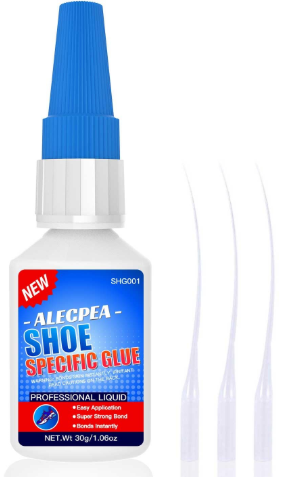
Description:
ATLASBOND Ceramic Glue is a high-performance adhesive designed for repairing ceramics, porcelain, pottery, and china. Its rapid-setting formula ensures a strong, clear bond, making it ideal for both functional and decorative items.
Key Features:
- Rapid-setting formula for quick repairs
- Clear drying finish for seamless restoration
- Waterproof and heat-resistant properties
- Food-safe adhesive, certified by MSDS and SGS
- Includes precision applicator tips for accurate application
Pros:
- Fast-drying, reducing wait time
- Invisible repairs that blend with the original surface
- Safe for use on items that come into contact with food
- Versatile for various materials beyond ceramics
Cons:
- May require multiple applications for larger repairs
- Not suitable for structural repairs requiring heavy-duty bonding
Recommendation:
Ideal for quick, clean repairs of ceramic items like mugs, plates, and decorative pieces. Its food-safe certification makes it a top choice for kitchenware restoration.
2. Ankita Ceramic Glue – 30g
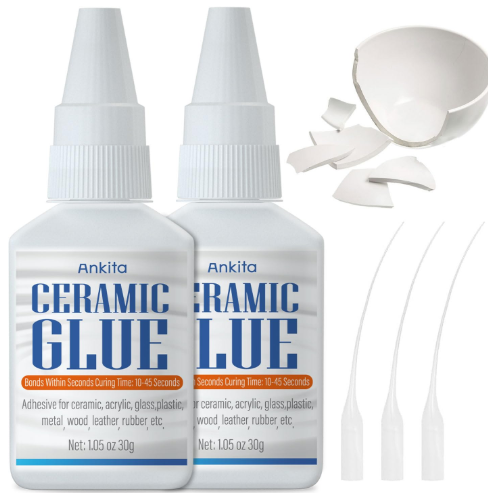
Description:
Ankita Ceramic Glue offers a durable bond for ceramics and pottery, with a clear drying formula that ensures repairs are nearly invisible. Its versatility extends to other materials, making it a handy adhesive for various household projects.
Key Features:
- Clear drying for discreet repairs
- Strong adhesion suitable for ceramics and pottery
- Versatile use on other materials like glass and plastic
- Easy application with included precision tips
Pros:
- Provides a strong, lasting bond
- Dries clear, maintaining the item’s appearance
- Multipurpose use beyond ceramics
- Affordable pricing for the quantity
Cons:
- May not be suitable for high-stress or load-bearing repairs
- Requires careful application to avoid excess glue
Recommendation:
Best suited for repairing decorative ceramics and pottery. Its affordability and versatility make it a great choice for general household repairs.
3. Ceramic Super Glue – 35g
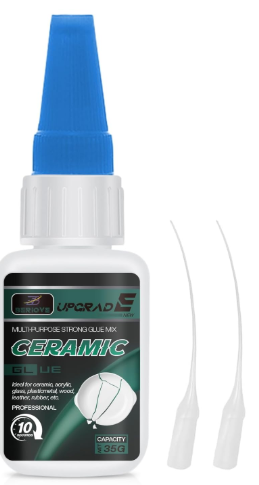
Description:
This Ceramic Super Glue is formulated for strong, durable bonds on ceramics, porcelain, and pottery. Its heat-resistant and waterproof properties make it suitable for items exposed to varying temperatures and moisture.
Key Features:
- Heat-resistant and waterproof
- Clear drying for seamless repairs
- Suitable for ceramics, porcelain, and pottery
- Comes in a 35g bottle for extended use
Pros:
- Ideal for items exposed to heat or moisture
- Provides a strong and lasting bond
- Clear drying ensures repairs are discreet
- Large quantity offers value for money
Cons:
- May require longer curing time compared to other adhesives
- Not suitable for flexible materials
Recommendation:
Perfect for repairing ceramics and pottery items that are frequently exposed to heat or moisture, such as mugs, teapots, and planters.
4. Cocomfix Ceramic Glue – 30g
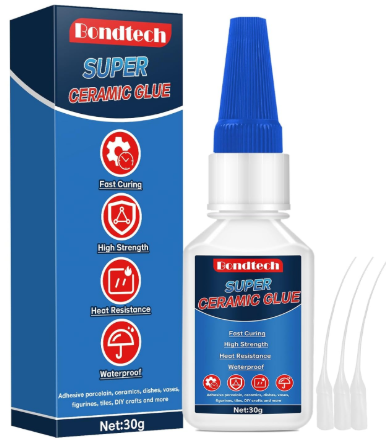
Description:
Cocomfix Ceramic Glue is a specialized adhesive for pottery repairs, offering excellent adhesion and quick-drying properties. It’s designed to handle porous surfaces, ensuring a strong bond even on intricate ceramic pieces.
Key Features:
- Specially developed for pottery repairs
- Quick-drying formula
- Handles porous surfaces effectively
- Comes with precision applicator tips
Pros:
- Strong adhesion on various ceramic surfaces
- Quick-drying, reducing repair time
- Includes applicator tips for precise application
- Suitable for intricate and detailed repairs
Cons:
- May not be suitable for non-ceramic materials
- Requires careful handling to avoid excess glue
Recommendation:
Ideal for detailed and intricate pottery repairs. Its quick-drying formula and precision applicator tips make it a go-to choice for delicate restoration projects.
5. Vigorder Ceramic Glue Repair Kit
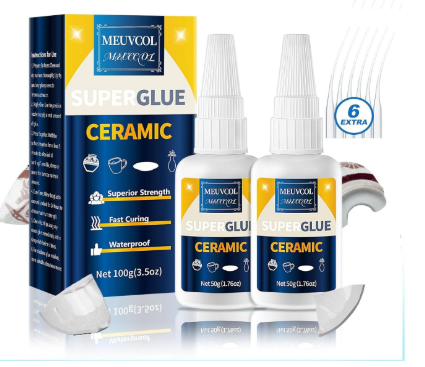
Description:
The Vigorder Ceramic Glue Repair Kit is a comprehensive solution for repairing ceramics, porcelain, and pottery. It includes a clear adhesive that’s waterproof and heat-resistant, ensuring durable repairs for various items.
Key Features:
- Includes clear adhesive for discreet repairs
- Waterproof and heat-resistant properties
- Suitable for ceramics, porcelain, and pottery
- Comprehensive kit for various repair needs
Pros:
- Ideal for a range of ceramic repair projects
- Provides a strong and lasting bond
- Waterproof and heat-resistant, suitable for various environments
- Comprehensive kit includes necessary tools
Cons:
- May not be suitable for non-ceramic materials
- Requires careful application to avoid excess glue
Recommendation:
Best suited for comprehensive ceramic repair projects. The kit provides all necessary tools for effective restoration, making it a convenient choice for various repairs.
6. Nexkayee Fast-Drying Porcelain Adhesive
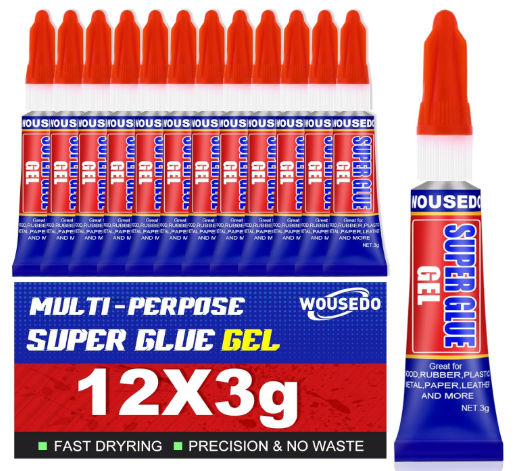
Description:
Nexkayee Fast-Drying Porcelain Adhesive is designed for quick and effective repairs of porcelain and ceramic items. Its fast-drying and waterproof properties make it ideal for items exposed to moisture.
Key Features:
- Fast-drying formula for quick repairs
- Waterproof properties
- Suitable for porcelain and ceramic items
- Includes precision applicator tips
Pros:
- Quick-drying, reducing wait time
- Waterproof, suitable for items exposed to moisture
- Includes precision applicator tips for accurate application
- Ideal for household items like mugs and dishes
Cons:
- May not be suitable for high-stress or load-bearing repairs
- Requires careful application to avoid excess glue
Recommendation:
Ideal for quick repairs of household ceramic items exposed to moisture. Its fast-drying and waterproof properties make it a convenient choice for everyday fixes.
Comparison Table:
| Product Name | Key Strengths | Ideal For |
|---|---|---|
| ATLASBOND Ceramic Glue – 20g | Fast-drying, food-safe | Kitchenware and decorative items |
| Ankita Ceramic Glue – 30g | Clear drying, multipurpose use | General household repairs |
| Ceramic Super Glue – 35g | Heat-resistant, waterproof | Items exposed to heat or moisture |
| Cocomfix Ceramic Glue – 30g | Quick-drying, precision applicator | Intricate pottery repairs |
| Vigorder Ceramic Glue Repair Kit | Comprehensive kit, strong bond | Comprehensive ceramic repairs |
| Nexkayee Fast-Drying Porcelain Adhesive | Quick-drying, waterproof | Household items exposed to moisture |
Conclusion:
Selecting the right glue for ceramics and pottery depends on the specific requirements of your repair project. For quick, clear, and food-safe repairs, ATLASBOND Ceramic Glue is an excellent choice. If you’re dealing with items exposed to heat or moisture, consider the Ceramic Super Glue – 35g for its heat-resistant and waterproof properties. For intricate repairs, the Cocomfix Ceramic Glue – 30g offers precision application. For comprehensive repair needs, the Vigorder Ceramic Glue Repair Kit provides all necessary tools. Lastly, for household items exposed to moisture, the Nexkayee Fast-Drying Porcelain Adhesive is a reliable option. Always ensure to follow the manufacturer’s instructions for optimal results.
How to Use Glue for Ceramics and Pottery
1. Prepare the Surface
- Ensure the ceramic or pottery pieces are clean, dry, and free from dust, grease, or debris.
- Wash with mild soap and water if necessary, then let the pieces dry completely.
2. Choose the Right Glue
- For small chips or cracks, super glue or fast-drying adhesives work best.
- For larger breaks or structural repairs, two-part epoxy provides a stronger, more durable bond.
- For items exposed to heat or water, select a waterproof and heat-resistant adhesive.
3. Apply the Glue
- Use sparingly: Only apply enough glue to cover the joining surfaces. Excess glue can squeeze out and be messy.
- For epoxy, mix the two components thoroughly according to instructions before applying.
- Use precision tips or applicators to target cracks and edges accurately.
4. Join the Pieces
- Press the ceramic or pottery pieces together firmly, aligning them carefully.
- Hold in place for the recommended time (usually a few seconds for super glue, longer for epoxy).
5. Secure and Let Cure
- For larger pieces, use clamps, rubber bands, or tape to hold parts in place while curing.
- Follow the glue manufacturer’s curing time instructions. Some epoxies may take 24 hours or more for full strength.
6. Clean Excess Glue
- Immediately wipe away any excess glue with a damp cloth or cotton swab before it dries.
- Avoid scraping dried glue, as it may damage the ceramic surface.
7. Post-Curing Care
- Allow the glued item to fully cure before using it or placing it under stress.
- Avoid exposure to heat, water, or weight until curing is complete unless the glue specifies it’s safe for such conditions.
Safety Guide for Using Ceramic and Pottery Glue
1. Work in a Well-Ventilated Area
- Many adhesives, especially epoxies and super glues, release fumes. Adequate ventilation reduces inhalation risks.
2. Wear Protective Gear
- Use gloves to avoid skin contact.
- Safety goggles are recommended to prevent accidental splashes in your eyes.
3. Avoid Skin and Eye Contact
- If glue contacts skin, wipe immediately with a cloth and wash with soap and water.
- For eye contact, rinse with plenty of water and seek medical attention.
4. Keep Away from Children and Pets
- Glue is toxic if ingested and can cause burns or irritation. Store out of reach.
5. Use Correct Amounts
- Using excessive glue can cause messy bonds, dripping, or improper curing.
- Follow the manufacturer’s instructions for optimal results.
6. Avoid Heat and Open Flames
- Many adhesives are flammable before curing. Keep away from heat sources and open flames.
7. Proper Storage
- Store glue in a cool, dry place with the cap tightly sealed.
- Check expiration dates; expired glue may not bond properly.
8. Disposal
- Do not pour leftover glue down the drain. Follow local disposal guidelines for chemical adhesives.
✅ Following these usage and safety guidelines ensures strong, durable repairs while protecting your health and preserving the integrity of your ceramic or pottery items.
Frequently Asked Questions (FAQs)
1. What is the best glue for repairing ceramics?
- Two-part epoxy provides the strongest bond and is ideal for larger breaks or structural repairs.
- Super glue (cyanoacrylate) is best for small chips or cracks.
- For kitchenware, look for food-safe, waterproof adhesives.
2. Can I use glue on mugs and plates?
Yes, but ensure the adhesive is food-safe and waterproof. Avoid using non-certified glues for items that will come into contact with food or drink.
3. How long does ceramic glue take to dry?
- Super glue: usually sets within seconds to a few minutes.
- Epoxy: can take 5–30 minutes to set and 24 hours to fully cure, depending on the brand.
4. Can I use any adhesive for outdoor ceramic items?
- Only use glues labeled waterproof and weather-resistant. Epoxies often provide the best long-term durability for outdoor use.
5. How do I avoid excess glue and messy repairs?
- Apply glue sparingly and use precision tips or applicators.
- Wipe away any excess immediately before it dries.
6. Is it safe to use metal tools to press glued ceramics together?
- It’s better to use clamps, rubber bands, or soft pressing tools to avoid scratching or chipping the ceramic surface.
7. Can glued ceramics be heat-resistant?
- Only if the adhesive is specifically labeled as heat-resistant. Normal glue may soften or fail under high temperatures.
Conclusion
Repairing ceramics and pottery can be simple and effective with the right glue. Choosing a high-quality adhesive ensures strong, long-lasting bonds, clear drying, and seamless repairs, whether for decorative pieces, kitchenware, or pottery.
Key considerations include glue type, bond strength, drying time, water and heat resistance, and safety features. Using proper application techniques and following safety guidelines prevents damage to your items and ensures reliable, professional-quality results.
By selecting the best glue for ceramics and pottery and handling it carefully, you can restore broken items with confidence and keep your cherished pieces looking beautiful and functional for years to come.